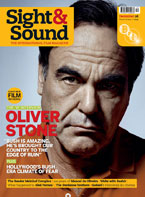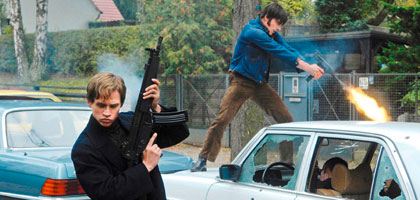
Radical Chic

The Baader Meinhof Complex has revived old disputes between the victims of the terrorist gang and its sympathisers in Germany. But is it out to glamorise terrorism, or does it revisit a phenomenon with important lessons for today? By Andrea Dittgen
The Baader Meinhof Complex is the most significant German film of the year, a unique mixture of action thriller and docudrama that looks at the most prominent years in the lifespan of a brutal and iconic terrorist group. Not only is it the nation's Oscar candidate for best foreign language film, but it also moved domestic audiences, taking more than 1.3 million admissions in the first two weeks and provoking fierce debate across the country.
From 1968 until the 1990s West Germany endured many violent attacks by the Baader-Meinhof Group (later known as the Red Army Faction, or RAF). Their murderous burning, bombing, kidnapping and bank robbery campaigns threatened the stability of the still fragile post-war Republic. Three crucial events are credited with radicalising RAF leaders Andreas Baader, Gudrun Ensslin and their comrades towards this violent response: a policeman shooting student Benno Ohnesorg in the head at a 1967 Berlin demonstration against the Shah of Persia (the policeman was acquitted); a moving revolutionary speech made by student Rudi Dutschke in 1968; and a right-wing assassination attempt on Dutschke not long afterwards.
The first phase of the group's campaign consisted of setting fire to department stores and bombing establishment newspapers. Baader and Ensslin, children of the post-Nazi generation, saw the US actions in Vietnam, the Middle East and the Third World as a new kind of fascism. They decided to retaliate by attacking the institutionsof big business and the pro-government media, thereby inconveniencing a German government seen as complicit with US policy and insufficiently de-Nazified. Though from today's perspective it looks like they were tilting at windmills, these violent activists soon established a large fan base among the young, radical left. They were a seemingly attractive group willing to die for their political beliefs and their actions soon forced the entire country to engage with the politics of the day.
The Baader Meinhof Complex is based on Stefan Aust's 1985 bestselling non-fiction book of the same name (Aust is a former editor-in-chief of the German news magazine Spiegel). It is the first film to cover the entire active history of the original RAF up to the 1977 suicide of its leaders in Stammheim prison. What's unique and surprising about the film is that it tries to integrate disparate details that were conspicuously missing in previous RAF films. Anyone who was alive at the time when the RAF murdered more than 30 people understands that there is no other way for a film to deal with this enormously complex topic.
Germany is of course always dealing with its past. The first film about the RAF to appear was Germany in Autumn (1978). Eleven different directors put it together - Rainer Werner Fassbinder, Alexander Kluge, Volker Schlöndorff and Edgar Reitz among them. Conceived in October 1977,a week after the Stammheim deaths, this portmanteau patchwork illustrates how clueless and helpless German citizens were in the face of this political turmoil. One documentary episode shows the funeral of Hanns-Martin Schleyer alongside the funeral of the terrorists. It has factory workers observing a moment's silence and shows them debating the events. In another section we see Fassbinder debating and struggling with his conservative mother. In a piece written by Heinrich Böll, Schlöndorff plays a theatre director staging Sophocles' Antigone; his production is censored because it could be interpreted as a call for violence. Other episodes put the mechanisms of the West German government side by side with those of the Nazis. Its irony, humour and creativity make Germany in Autumn a must-see for all directors looking at the RAF years.
Later films tend to concentrate on a single aspect of the group, courting controversy by more or less taking the terrorists' position. Margarethe von Trotta's The German Sisters (1981) shows how siblings Marianne and Juliane (alias Gudrun and Christiane Ensslin) develop differently while growing up with a pastor father in a repressive, intellectual, middle-class family in the 1950s. Reinhard Hauff's tough trial-reconstruction drama Stammheim - Die Baader-Meinhof-Gruppe vor Gericht (1986), meanwhile, portrays the terrorists insulting their judges, but makes no comment on them itself. Hauff was offended when his film was widely seen as a disguised indictment of the government.
It took almost 15 years - a whole generation - before other aspects of the RAF were shown on film. In The Legend of Rita (2000) Schlöndorff concentrates on the second-generation RAF, whose members barely knew Baader, Meinhof or Ensslin and who fled to the German Democratic Republic. Former terrorist Inge Viett accused Schlöndorff of plagiarising her biography. The audience didn't much like this new quotidian approach to terrorist life and critics were unhappy with the film's lack of political context. Hardly anyone much liked Baader (2002) either, in which director Christopher Roth combined terrorism with pop aesthetics, showing Baader as an urban guerrilla and macho lover, venerating him as if he were Jesse James in a Western. Roth even gave him a fictitious death in a violent shoot-out with the police.
Director Gerd Conradt studied at the Berlin Film Academy with RAF terrorist Holger Meins, who starved to death in prison during a hunger strike. He had campaigned alongside Meins at first, but quit when the odd Molotov cocktail was replaced by machine-guns. Conradt's documentary Starbuck Holger Meins (2002) takes the intimate approach of interviewing many people from that time, employing archive footage and asking the same personal questions: what turned Meins into a terrorist? What caused his death and transformed him into a martyr of radical resistance?
Andres Veiel did something similar in his documentary Black Box BRD (2001), but more impersonally. He concentrated on RAF terrorist Wolfgang Grams, who had participated in the murder of banker Alfred Herrhausen. But until now only Christian Petzold has tried to reach the audience emotionally. In his The State I Am In (2000) a left-wing terrorist couple are on the run from the police for 15 years, living all across the new Europe. The film is unique in the genre because it focuses on the couple's daughter, who falls in love and tries to escape the prison of silence her parents have built around her.
But one key RAF story element was still neglected: how did successful journalist Ulrike Meinhof become involved in the group? The Baader Meinhof Complex tries to deal with Meinhof's transformation from a bourgeois to a radical. We see her walk out on her cheating husband, then she's a brave mother and a journalist on a left-wing magazine. But when she helps the imprisoned Baader to escape and spontaneously jumps out of the window after him, she has no choice but to join the RAF and leave her children. Meinhof was Baader's lover for only a short while. Though Baader is seen to shout a lot - including the memorable line "shooting is like fucking" - Ensslin and the other RAF women are stronger characters than the men. Indeed, it is they who argue for violent action over talk, thus preparing us for the 60 minutes of this 150-minute feature that play like a Hollywood action movie. There's plenty of brooding, sexy, legs-akimbo posturing too, though without much actual sex: the girls sunbathe naked at the PLO camp, upsetting their Muslim "brothers", and Baader is nonchalant when he finds girlfriend Ensslin in the bathtub with Peter-Jürgen Boock… but that's all we see.
Bernd Eichinger (Downfall, 2004; Perfume: The Story of a Murderer, 2006) is probably Germany's most powerful and daring producer. He talked Uli Edel (Last Exit to Brooklyn, 1989; Body of Evidence, 1993), his old friend and former co-student at the Munich Film Academy, into directing the RAF movie. "It's a film about our generation," Eichinger says. "You have to do it." Eichinger, a producer since the 1970s, has that rare ability to tackle the most controversial subjects of Germany's recent past at exactly the right moment. But though he co-wrote the script to maintain control, he is not, in truth, a very talented writer. With bombast to the fore, the dialogue is often unintentionally humorous: "It's no use praying for a better world," for instance, or "May their pain be the mirror of our pain." Nevertheless Eichinger has recalled the one tagline from terrorist Brigitte Mohnhaupt that sums up the unsolved problem of how to handle the RAF: "Stop seeing them the way they weren't."
The atmosphere created by scenes portraying the group from within is more reminiscent of the bored and bitchy denizens of Andy Warhol's Factory than of violent terrorists, even in the training-with-the-PLO scenes. This frivolous mood lingers for the entire film - even during the action scenes. However, the accurate reconstruction of the iconic images of the time using some of Germany's most talented actors such as Moritz Bleibtreu (as Baader), Martina Gedeck (as Ulrike Meinhof) and Johanna Wokalek (as Gudrun Ensslin) successfully evokes the paranoia of 1970s West Germany.
Of course, not everything is portrayed according to the facts and placed in the right time window. The public reaction to the film has hardly been surprising, upsetting those who witnessed what happened and infuriating RAF victims - from the former minister of the interior (Gerhard Baum), to the daughter of Ulrike Meinhof (Bettina Röhl, a journalist). Corinna Ponto, the widow of banker Jürgen Ponto, who was kidnapped and shot by the group, returned her Federal Cross of Merit as a protest against what she described as a "whole new level of public indignity".
Some former RAF members accuse the production of being a purely financial enterprise. Other people who stayed on the sidelines find nothing new in its visual composition or the way that Edel places one action scene after the other as if he were chronologically listing the history of the RAF. Yet what else lingers in the memory after 30 years if not the famous pictures of murder, kidnapping and violence? Words in a courtroom can't compete. The main achievement of The Baader Meinhof Complex is to have introduced a new generation to the RAF and to have given Germany a chance to reflect on its legacy by telling the story from the terrorists' perspective without siding with them. That is something.
